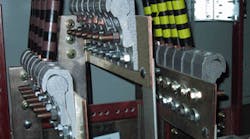With stored energy wire connectors, the wire is held intact regardless of vibration and thermal cycling.
More than 25 yr ago, back-wired devices were installed throughout the commercial and residential electrical market. Although they worked and were economically efficient, they sometimes suffered from arcing, which led to carbon buildup along the spring-loaded copper contacts. Many electrical workers believed the spring-like, stored-energy contacts were problematic because they lacked sufficient contact surface area. As a result, most refused to use them anymore.
More recently, the International Electrotechnical Commission (IEC) introduced another form of spring-loaded, stored-energy contacts, forcing the industry to re-evaluate the use of stored energy connector.
Traditionally used for very small power circuits and control circuits in both commercial and industrial building management and DCS systems, the new stored-energy terminals fall into two categories:
-
A new form of the old “punch down block” or “terminal block” that has been used for years in the telephone industry.
-
A totally new concept in which a spring pushes against the back half of the connector, holding together the two mating halves of the terminal block.
To load the wire into the spring-loaded terminal, the electrician must force the two halves apart with a screwdriver or similar lever, insert the stripped wire into the opening, and then remove the tool to release the force of the spring. The spring then forces the two halves of the terminal into intimate contact with the wire. When the wire is held in this manner, vibration and the coefficient of thermal expansion of the conductors are of no consequence. In the past, if you were working with a terminal that had a setscrew, you had to worry about the screw contacting the wire and causing damage. Fortunately, the setscrew on new connectors only pushes against the spring-loaded terminal, so there is no way that thermal cycling or vibration of the setscrew can cause the wire termination to loosen, nor can the twisting of the setscrew deform the wire.
This same concept also led to the design of stored energy connectors for large power cables. A “spring-loaded” connector designed for use with power cables makes sense, particularly where intermittent loads or machine vibration thermal cycling is prevalent or where cold flow is a concern. In addition, the connectors are made of an aluminum alloy, coated with an EC-90 anti-corrosion coating and using anti-oxidant compound to assure compatibility between dissimilar metals.
These UL-approved, stored-energy terminations offer fast termination time using only standard socket tools and end wrenches. When you first insert wire into the opening of this type of connector, 30° of space will separate both halves of the connector. As you tighten the bolt, however, the compression force will bend one of the halves, pinching or holding the wire in place. Most importantly, these connectors always remain tight using interacting levers, which generate a constant, repeatable pressure connection regardless of the electrical currents to which they are subjected. It’s important to note, however, that you still must not over-torque the mounting bolts, which causes them to stretch and lose tensile strength.
Just as with the stored energy wire terminators for small wires, these new connectors for large cables are designed so that a setscrew can’t damage the conductor strands or loosen from vibration. A single bolt securely holds together both pieces of the connector, which are rated at 90°C (see photo, right). The metal-to-metal conductive surface area is under continuous pressure, which assures a low electrical resistance. The constant pressure between the machined lug surfaces minimizes the potential for galvanic corrosion on these important conductive surfaces. Separate bolt hardware secures the lug to the bus bar, using the familiar Bellville washer technology. Since the second bolt can be installed through the lug and the equipment bus bar, the stored energy of the connector can simultaneously assure continuous tight contact pressure between the wire and the lug, as well as between the lug and the bus bar.
To make installations even more rapid and cost-effective, multiple wire lugs are available factory-mounted on a single “power bar” (see photo, right). This eliminates the need for several forms of taps and kerneys, while simultaneously negating the possibility of setscrew loosening, which sometimes occurs with stranded conductors.
Offering the benefits of minimal installation effort and material and tooling costs, new forms of stored-energy termination are putting an old technology to new use in the electrical industry. Although spring-loaded, stored-energy problems encountered resistance from electrical workers more than 25 yr ago, improvements to their design that promote longevity and circuit dependability have made them a viable option for the termination of large cables today.



